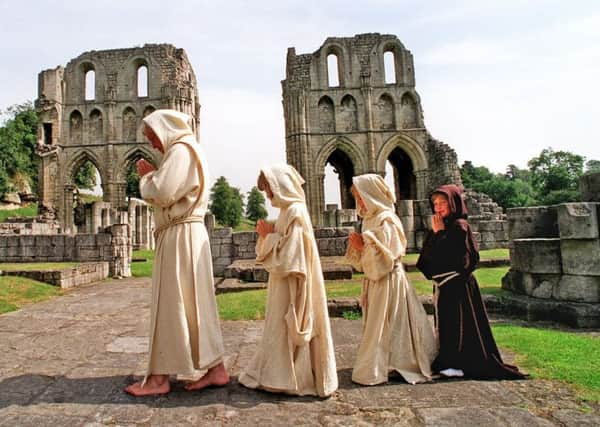The Abbey habit


The abbey’s deed of surrender was signed on June 23, 1538, and around 30 years later Michael Sherbrook (1535-1610), rector of the nearby parish of Wickersley, listened intently as his father and uncle recounted details of its suppression. The event at Roche took place when he was a child but once knowing all the facts he then catalogued the information, which has been passed down through the centuries. His account is considered to be one of the most important sources detailing an abbey’s destruction.
Sherbrook states the abbey was functioning normally until the date of suppression with locals attending vespers in the abbey church. Immediately afterwards, a mob arrived and pilfered whatever was available.
Advertisement
Hide AdAdvertisement
Hide AdSherbrook’s father recalled that Roche Abbey’s ransacking would have pitied any heart, “to see the tearing up of the lead, the plucking up of boards and throwing down of the rafters...All things of price were either spoiled, [taken away] or defaced to the uttermost and it seemed that every person bent himself to filch and spoil what he could”. Parchment from manuscripts and service books was made use of and many of the buildings, including the church, were pillaged.


A little later some of the monastery’s possessions were offered at a public auction. Amongst the items were floor tiles and window glass and even Sherbrook’s father purchased several loads of timber from the steeple.
Roche Abbey was founded as a monastery of the Cistercian order in 1147, by a party from Newminster Abbey, Northumberland, comprising 12 monks, an abbot and around 20 lay brothers.
The abbey’s location, in a narrow valley with rock outcrops in the hills east of Rotherham, appealed to the monks as a secluded area where they could carry out their commitment to the work of God. Another advantage was an abundant water supply provided by Maltby and Hooten dikes.
Advertisement
Hide AdAdvertisement
Hide AdThe donors of the land were two local lords, Richard de Bully, Lord of Maltby, and Richard, son of Turgis. Initially, the abbey was made up of timber buildings but as the income grew they were replaced by stone structures. The fine stonework within the abbey shows it to be distinctively French and the style of architecture definitely Gothic. The latter style was developed in and around Paris in the 1140s and appeared in the north of England in the 1160s.


Around 1175, Roche Abbey numbered about 50 monks and 100 working lay brothers and servants. It was a medium sized abbey compared with the Cistercian order’s other seven Yorkshire abbeys, and comprised a walled precinct containing a series of buildings and enclosures, with the church and cloister at the centre.
At the monastery’s peak, the community of about 150 was composed of one-third monks and two-thirds lay brothers.
A brief ceremony in the Chapter House in 1538 saw Roche Abbey handed over to commissioners of the King. At this time, the Roche community comprised 17 monks, four novices and some paid servants.
Advertisement
Hide AdAdvertisement
Hide AdAfter passing through a succession of private owners the valley and adjacent lands eventually came into the possession of the 3rd Earl of Scarborough, Thomas Lumley (c.1691-1752). In 1774, the 4th Earl of Scarborough (1725-1782) discussed ideas for the Roche Abbey area’s development with landscape gardener Lancelot ‘Capability’ Brown (1716-1783). The gardener was then issued with a contract “to finish all the valley of Roche Abbey in all its parts, according to the ideas fixed on with Lord Scarborough (with Poet’s feeling and with Painter’s eye)”.


Brown was to earn £2,700 (about £4.5m today) for the ambitious work though he fell out with the Earl in 1779 with only a portion of the job undertaken. Brown’s foreman, Adam Mickle, his son and other workmen continued with the project. A banqueting lodge was erected in 1777 for entertaining and for viewing the landscape.
Not everyone admired Brown’s attempt to enhance an historic ruin. One critic said his landscaping “was too magnificent and too artificial an appendage to be in union with the ruins of an abbey”.
During the 19th century landowners wanted historic sites to be verified and explored in depth, and Brown was accused by local antiquarian James Aveling of “creating havoc” at Roche Abbey. Beginning in the late 1850s, Aveling with the permission of the 9th Earl of Scarborough, began a series of small excavations to determine a full ground plan of the church and cloister. Further clearance of the site occurred during the remainder of the century. The abbey was open to the public from the 1880s.
Advertisement
Hide AdAdvertisement
Hide AdAfter the First World War, Roche Abbey was taken over by the state continuing with its upkeep and archaeological recording. Further parts of the abbey were exposed and consolidated. Today the lofty early Gothic transepts of Roche Abbey still survive to their original height and are considered to be amongst the finest early Gothic architecture in the UK. It also has one of the most complete ground plans of any Cistercian monastery, laid out as excavated foundations.
Special thanks to Peter Urmston and English Heritage for help with this piece